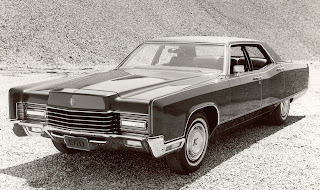The original Audi Quattro competition car debuted in 1980, first as a development car, and then on a formal basis in the 1980 Janner Rally in Austria. Largely based on the bodyshell of the road-going Quattro models (in contrast to the forthcoming Group B cars), the engine of the original competition version produced approximately 300 bhp (224 kW; 304 PS).
In 1981, Michèle Mouton became the first female driver ever to win a world championship rally, piloting an Audi Quattro.[1] Over the next three years, Audi would introduce the A1 and A2 evolutions of the Quattro in response to the new Group B rules, raising power from the turbocharged inline 5-cylinder engine to around 350 bhp (261 kW; 355 PS). The Quattro A1 debuted at the WRC 1983 season opener Monte Carlo Rally, and went on to win the Swedish Rally and the Rally Portugal in the hands of Hannu Mikkola. Driven by Stig Blomqvist, Mikkola and Walter Röhrl, the A2 evolution won a total of eight world rallies; three in 1983 and five in 1984.
Sport Quattro
The Audi Sport Quattro S1 was a Quattro programme car developed for homologation for Group B rallying in 1984, and sold as a production car in limited numbers. It featured an all aluminium alloy 2,133 cc (130.2 cu in) (2.1 L) 20v DOHC engine slightly smaller than that of the Audi Quattro (in order to qualify for the 3-litre engine class after the scale factor applied to turbo engines). In road-going form, the engine was capable of producing 225 kW (306 PS; 302 bhp) with the competition cars initially producing around 331 kW (450 PS; 444 bhp).The vehicle also featured a body shell composed of carbon-kevlar and boasting wider arches, wider wheels (nine inches as compared to the Ur-Quattro's optional 8-inch-wide (200 mm) wheel rim), the steeper windscreen rake of the Audi 80 (requested by the Audi Sport rally team drivers to reduce internal reflections from the dashboard for improved visibility) and, most noticeably, a 320 mm (12.6 in) shorter wheelbase.
In 1977 Ferdinand Pich (grandson of Ferdinand Porsche) Audi's Technical Development board member, had the objective to upgrade the position of the Audi brand through the introduction of innovative technology: "Vorsprung durch Technik". As an experiment, Audi engineer J�rg Bensinger developed an AWD arrangement for the Audi Iltis. Testing was not only promising but impressive. Audi's other board members wanted to promote a more stately model thus the Iltis guts into an Audi 80 and the prototype A1 (standing for "All-Wheel-Drive 1" was born. In September 1977 Audi gave engineers the green light to begin offical work on the A1 project (Development Code 262). Over the next few months the design was improved with the addition of a center differential among other changes. With only 30 minutes test-driving the car, the Finnish rally star Hannu Mikkola was convinced: "I have just experienced a convincing view of the future. Quattro will change the rally scene once and for all."
One of the most significant rally cars of all time made its introduction to the world in 1980, with the unveiling of Audi's rally contender, the Quattro. The Quattro was the first rally car to take advantage of the new rules permitting four-wheel-drive for rally competition, but there were some initial doubts about four-wheel-drive's suitability to rallying. Some thought it would be too complex and heavy to be competitive. The critics were quickly proven wrong.
The Quattro won its first rally on its first outing, the Austrian round of the European championship in 1981: the four-wheel-drive experiment was an instant success. The Quattro went on to win a couple rounds of the world rally championship, and Audi gained additional exposure when Michle Mouton won the 1981 San Remo rally, the first woman to win at the international level. The 1982 season looked set to be an Audi tour de force.
While the Audi was clearly the fastest and one of the most revolutionary rally cars in some time, it did have a number of shortcomings. The Quattro was rather heavy, its front-engine, monocoque chassis gave the car clumsy and unwieldy handling characteristics, and the car had problems with mechanical reliability. The car did win the 1982 championship for constructors, but Walter Rhrl took his first win of the year and the championship on the final event, the Ivory Coast rally, after Michle Mouton's Quattro suffered a broken transmission.
Der Audi quattro
Der Audi quattro, auch Urquattro genannt, ist ein Sportcoupé der Marke Audi, das zwischen Sommer 1980 und Mitte 1991 hergestellt wurde. Mit 11.452 gebauten Einheiten war er das erste in größeren Stückzahlen produzierte Straßenfahrzeug mit einem permanenten Allradantrieb und maßgeblich für die Erfolgsgeschichte des quattro-Antriebs von Audi sowie für den Einsatz des permanenten Allradantriebs in Straßenfahrzeugen generell verantwortlich. Zwar wurden Mitte der 1960er-Jahre bereits einige Straßenfahrzeuge mit einem permanenten Allradantrieb von Ferguson ausgestattet, jedoch mit mäßigem Erfolg. Dazu gehörten der Jensen FF, von dem lediglich 320 Fahrzeuge produziert wurden, sowie der Ford Zephyr mit Ferguson-Allradantrieb, von dem versuchsweise 22 Fahrzeuge für die britische Polizei gefertigt wurden. Aufgrund der hohen Produktionskosten wurde letztgenanntes Projekt nicht weiter verfolgt.
Die Produktion des Jensen FF wurde 1971 aufgrund mangelnder Vermarktungsmöglichkeiten ebenfalls eingestellt. 1972 brachte Subaru mit dem Modell Leone ein allradangetriebenes Straßenfahrzeug auf den Markt, welches allerdings lediglich mit einem zuschaltbaren Allradantrieb ausgestattet war. Bereits 1983 wurde die quattro GmbH gegründet, ferner war der permanente Allradantrieb optional für immer mehr Audi-Fahrzeuge verfügbar. Audi selbst bezeichnet das Modell Audi Coupé S2 als den offiziellen Nachfolger des Urquattro. [2] Das Wort quattro (ital. für vier) wird immer durchgehend in Kleinbuchstaben geschrieben. Auch das Original-quattro-Logo zeigt ausschließlich Minuskeln.












 Z
Z










































